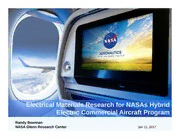
NASA Technical Reports Server (NTRS) 20170004748: Electrical Materials Research for NASAs Hybrid Electric Commercial Aircraft Program PDF
Preview NASA Technical Reports Server (NTRS) 20170004748: Electrical Materials Research for NASAs Hybrid Electric Commercial Aircraft Program
Electrical Materials Research for NASAs Hybrid Electric Commercial Aircraft Program Randy Bowman NASA Glenn Research Center Jan 11, 2017 Who is Funding Electrical Materials Work at NASA? Strategic Thrusts Guide NASA Investment Decisions Pioneer technologies for leaps in efficiency and environmental performance, i.e. blended wings, small-core turbine engines www.nasa.gov Program Hierarchy Aeronautics Research Mission Directorate (ARMD) Advanced Air Transport Technology (AATT) Hybrid Gas, Electric, Propulsion SubProject (HGEP) www.nasa.gov 3 Electrified Aircraft Propulsion Terminology Electrified Propulsion : Refers to the use of electric power for aircraft propulsion – Could be all or partially electric propulsion • Hybrid Electric has two meanings in aircraft context – One meaning is the use of two power sources, such as turbine engine and electric energy storage, to drive the same fan or propeller shaft—hybrid electric powertrain – Another meaning is the combination of more than one propulsive sources such as traditional turbofan engines augmented with electric drive enabled propulsion—hybrid electric propulsion • Turboelectric Propulsion: Use onboard generation as power source to drive fans or propellers – Turboelectric generation already provides electric power for secondary systems on aircraft www.nasa.gov Strategic Thrust 4 Low Carbon Propulsion Reduce fossil fuel usage and carbon emission while allowing aviation growth The Low Carbon Propulsion challenge is to enable carbon-neutral growth in aircraft operations. The proposed answer is a combination of alternative fuels and alternative propulsion 2015 2025 2035 Introduction of Low-Carbon Fuels for Conventional Introduction of Introduction of Alternative Engines and Exploration of Alternative Propulsion Propulsion Systems to Alternative Propulsion Systems at a Small Aircraft of All Sizes Systems Scale www.nasa.gov Electric options open the airplane design space Electrified Propulsion Vehicle Configurations Higher potential and longer term Potential for earlier entry into service Baseline Aircraft with Podded Turbo-Fan X-57 Maxwell 4 PAX Plane SUGAR VOLT 150 PAX Study ECO-150 150 PAX Studies AATT 50 PAX Studies Current NRA 150 PAX Studies N3-X 300 PAX Turbo-Electric STARC-ABL 150 PAX Study www.nasa.gov Machine Power Relevant to Aircraft Class Non-cryogenic Largest Electrical Machine on Aircraft Superconducting 100 kW 1 MW 3 MW 10 MW 30 MW 9 Seat 0.5 MW Total Propulsive Power NASA focusing on 1MW 50-250 kW Electric Machines machines to address a range 19 Seat 2 MW Total Propulsive Power of aircraft sizes – pathway to 0.1-1 MW Electric Machines commercial transports 50 Seat Turboprop 3 MW Total Propulsive Power 0.3-1.5 MW Electric Machines 50 Seat Jet 12 MW Total Propulsive Power 0.3-6 MW Electric Machines 150 Seat 22 MW Total Propulsive Power 1-11 MW Electric Machines 300 Seat 60 MW Total Propulsive Power 3 -30 MW Electric Machines www.nasa.gov Configurations Drive the Technology Investment The technology development needs determined from configuration studies • When selecting technology development investments, start with the technologies common to both. Energy Storage Electrical Dist. Turbine Integration Aircraft Integration Fan Operability with Stowing fuel & Battery Energy High Voltage different shaft batteries; swapping Density Distribution control batteries Battery System Thermal Mang’t of Small Core dev’t Aft propulsor design Cooling low quality heat and control & integration Power/Fault Mang’t Mech. Integration Integrated Controls Machine Efficiency Hi Power Extraction & Power Robust Power Elec. Parallel Hybrid Specific Common to both Turboelectric Specific www.nasa.gov Rationale for Material Investment …Weight, Weight, Weight Power system weights are very sensitive to • Electrical Efficiency • Component Specific Power • Distribution Voltage Key Material Technologies 600 v • Insulation Materials— enable higher distribution voltage • Magnetic Materials— 1200 v increase switching frequency and reduce component losses • Advanced Conductors— reduce weight. high risk / high payoff investment in new systems • Wide band gap semiconductors— increasing frequency increases efficiency Ref: Jansen et al., AIAA, 2016 www.nasa.gov 9 Hybrid Gas Electric Propulsion SubProject (HGEP) Technical Areas: Superconducting Insulation Motor (cryo) Advanced Magnetic Materials Non- Wide Bandgap Superconducting Semiconductors Motor Electrical Materials: Low Resistivity Conductors Component maturations for key enabling materials and subcomponents Superconducting • For superconducting machines need low loss AC Wire portions – conductors, etc • Must have higher voltages on the aircraft, thus insulation system development is required. • Magnetic critical for efficiency, and likely enabling. • Without higher conductivity material the electrical propulsion options for large vehicles is limited. www.nasa.gov
